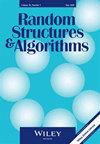Broadcasting‐induced colorings of preferential attachment trees
IF 0.8
3区 数学
Q4 COMPUTER SCIENCE, SOFTWARE ENGINEERING
引用次数: 1
Abstract
We consider random two‐colorings of random linear preferential attachment trees, which includes recursive trees, plane‐oriented recursive trees, binary search trees, and a class of d‐ary trees. The random coloring is defined by assigning the root the color red or blue with equal probability, and all other vertices are assigned the color of their parent with probability p$$ p $$ and the other color otherwise. These colorings have been previously studied in other contexts, including Ising models and broadcasting, and can be considered as generalizations of bond percolation. With the help of Pólya urns, we prove limiting distributions, after proper rescalings, for the number of vertices, monochromatic subtrees, and leaves of each color, as well as the number of fringe subtrees with two‐colorings. Using methods from analytic combinatorics, we also provide precise descriptions of the limiting distribution after proper rescaling of the size of the root cluster; the largest monochromatic subtree containing the root.广播诱导的优先依恋树着色
我们考虑随机线性优先连接树的随机二色,它包括递归树、面向平面的递归树、二叉搜索树和一类d - ary树。随机着色是通过以相同的概率将根分配为红色或蓝色来定义的,所有其他顶点都以p $$ p $$的概率分配为其父顶点的颜色,其他颜色则为其他颜色。这些着色以前已经在其他情况下进行了研究,包括Ising模型和广播,并且可以被认为是键渗透的概括。在Pólya urns的帮助下,我们证明了在适当的重新缩放后,每种颜色的顶点,单色子树和叶子的数量以及具有两种颜色的条纹子树的数量的极限分布。利用解析组合的方法,给出了适当调整根簇大小后的极限分布的精确描述;包含根的最大单色子树。
本文章由计算机程序翻译,如有差异,请以英文原文为准。
求助全文
约1分钟内获得全文
求助全文
来源期刊

Random Structures & Algorithms
数学-计算机:软件工程
CiteScore
2.50
自引率
10.00%
发文量
56
审稿时长
>12 weeks
期刊介绍:
It is the aim of this journal to meet two main objectives: to cover the latest research on discrete random structures, and to present applications of such research to problems in combinatorics and computer science. The goal is to provide a natural home for a significant body of current research, and a useful forum for ideas on future studies in randomness.
Results concerning random graphs, hypergraphs, matroids, trees, mappings, permutations, matrices, sets and orders, as well as stochastic graph processes and networks are presented with particular emphasis on the use of probabilistic methods in combinatorics as developed by Paul Erdõs. The journal focuses on probabilistic algorithms, average case analysis of deterministic algorithms, and applications of probabilistic methods to cryptography, data structures, searching and sorting. The journal also devotes space to such areas of probability theory as percolation, random walks and combinatorial aspects of probability.
 求助内容:
求助内容: 应助结果提醒方式:
应助结果提醒方式:


